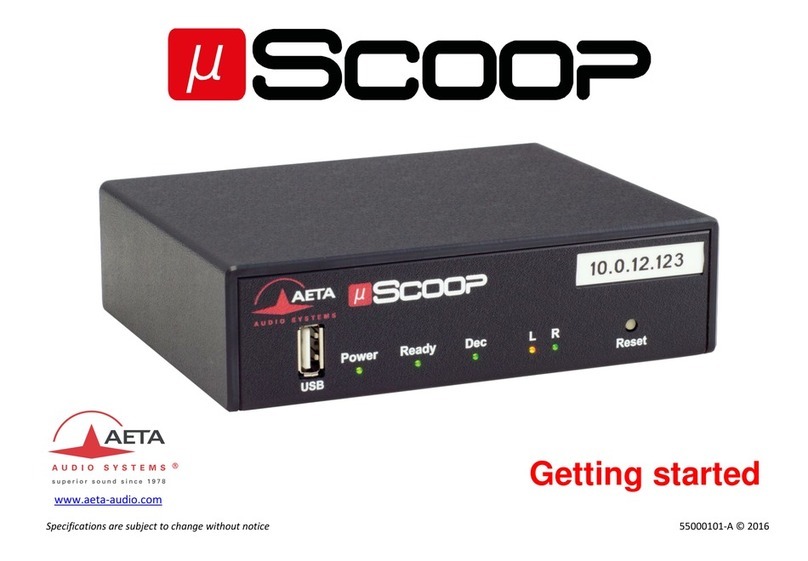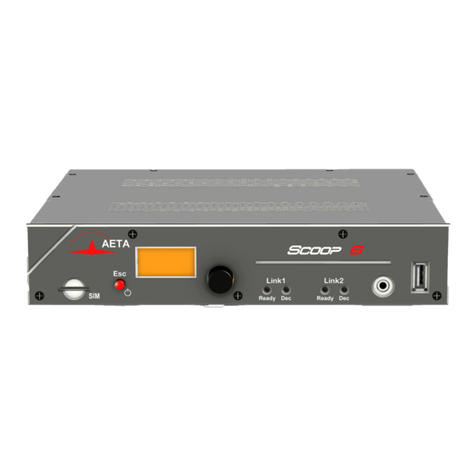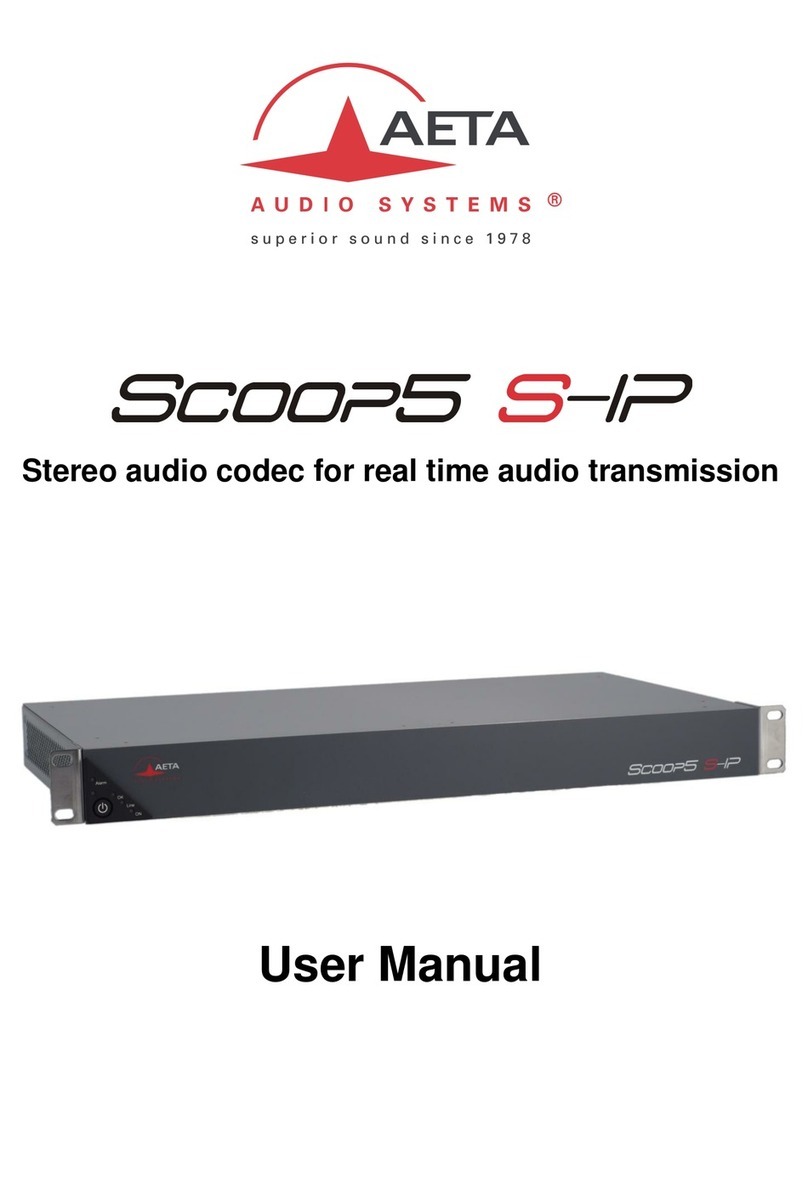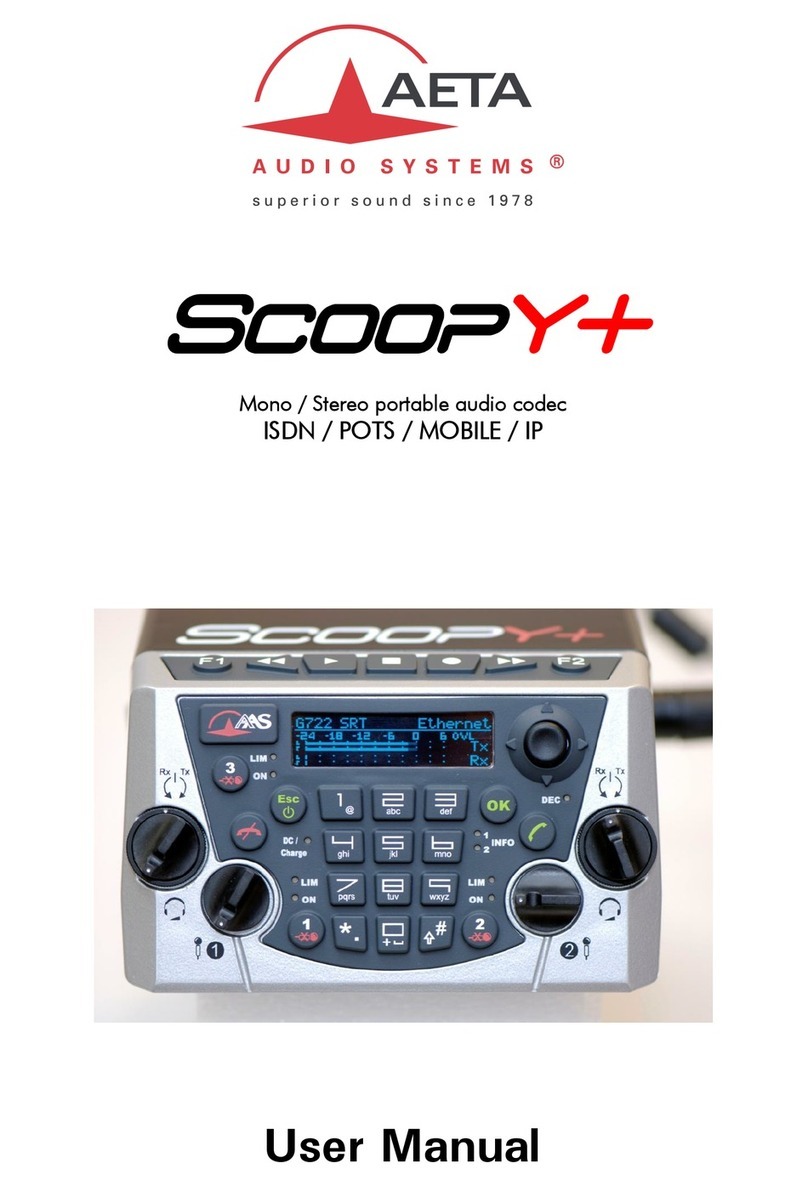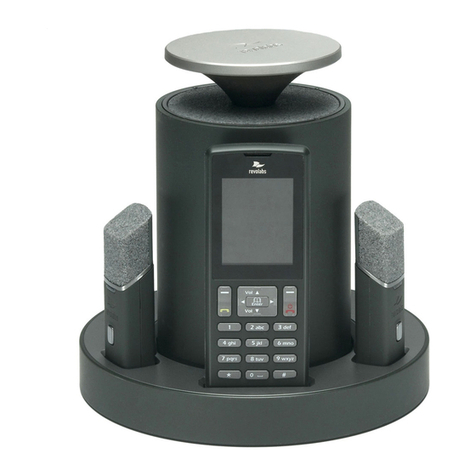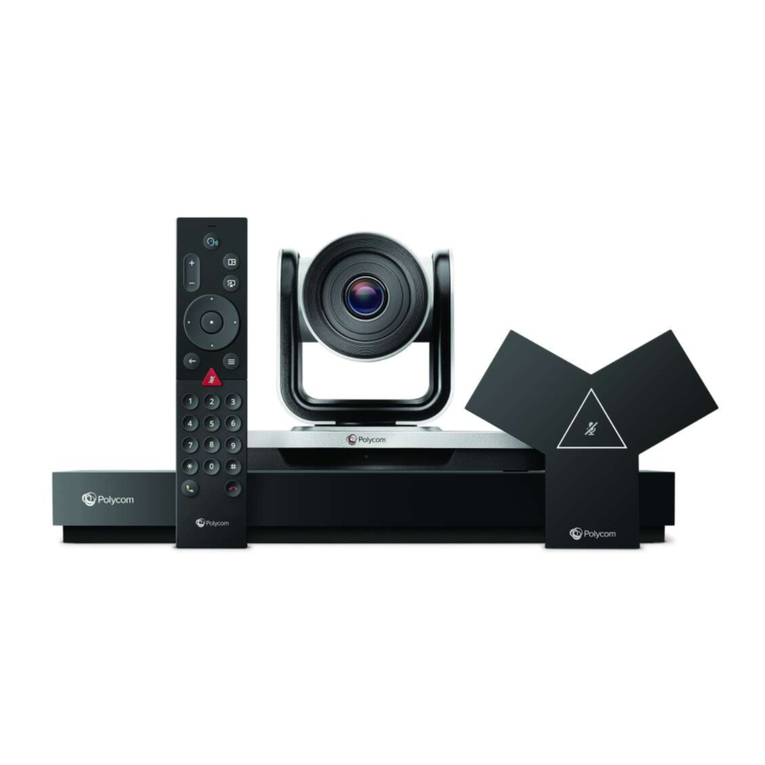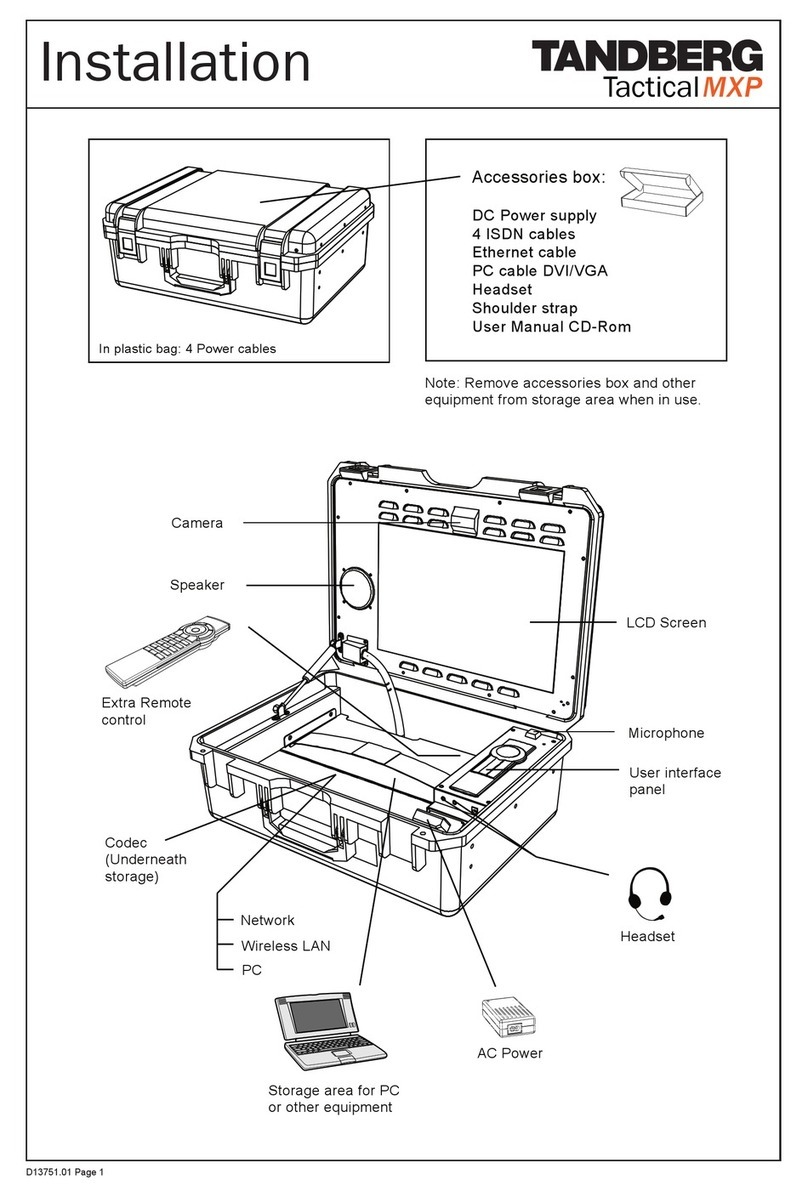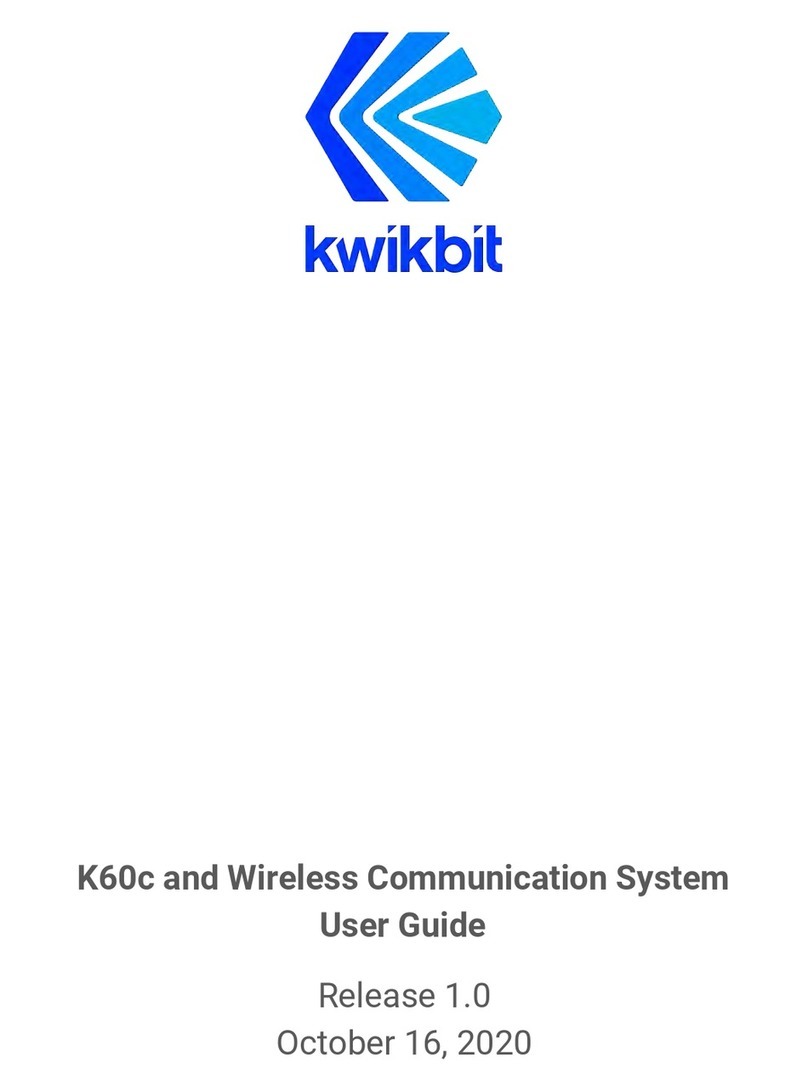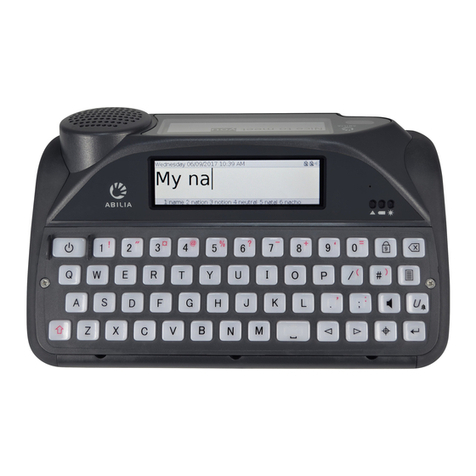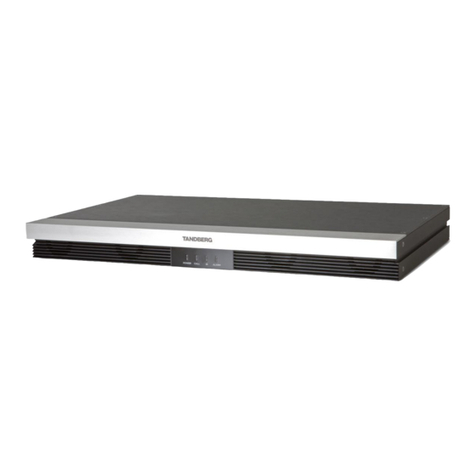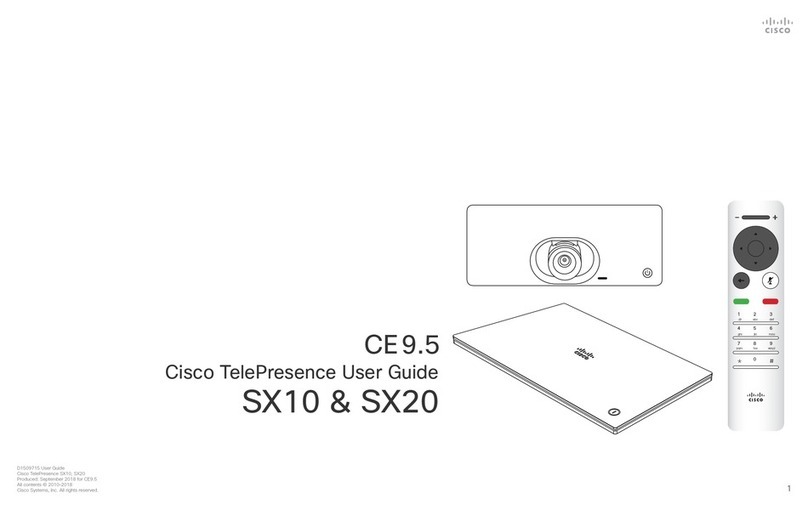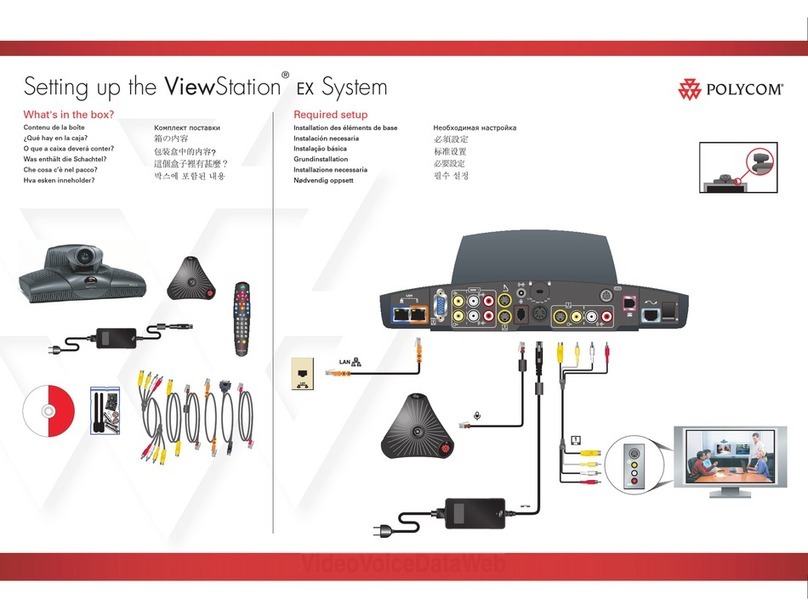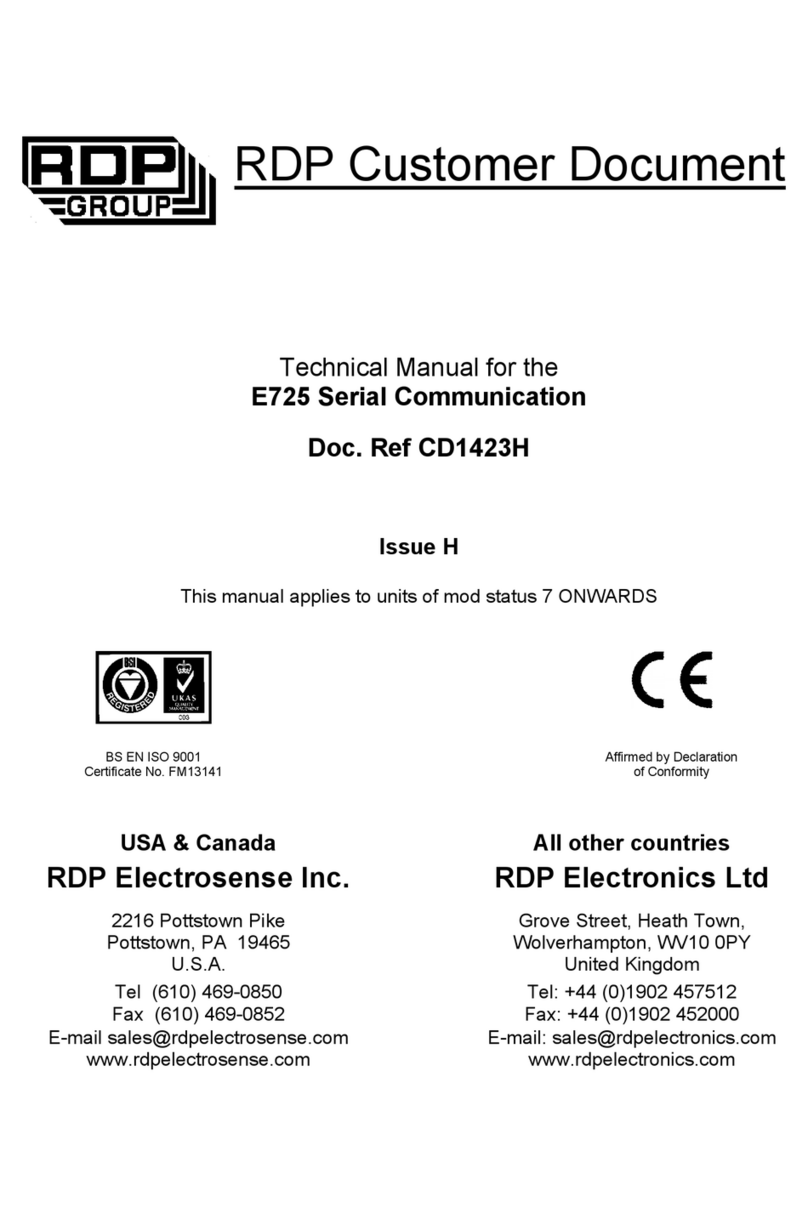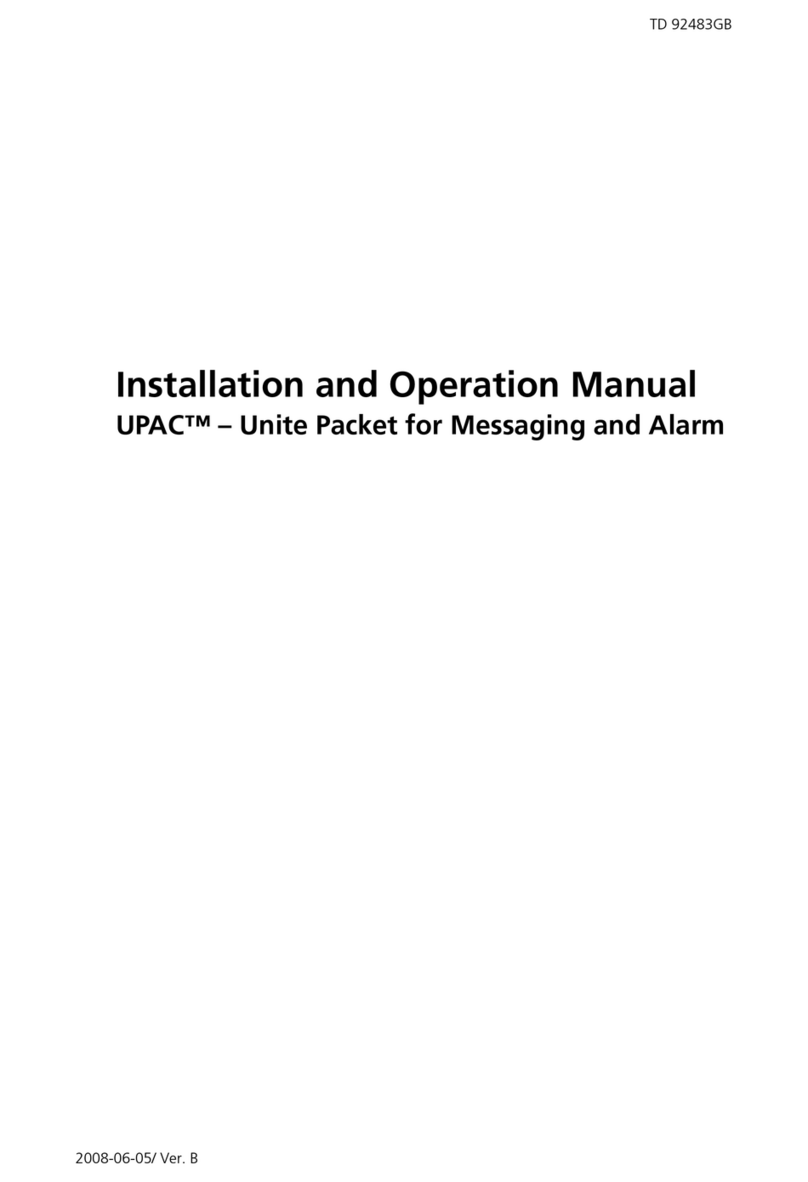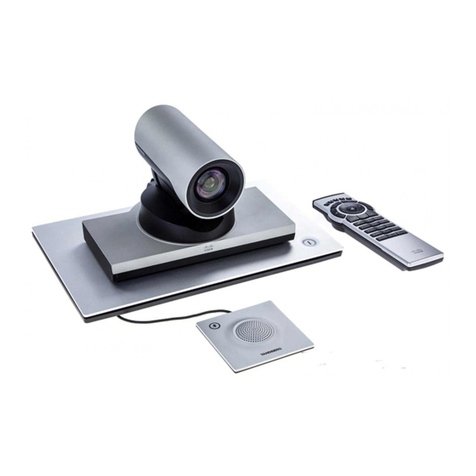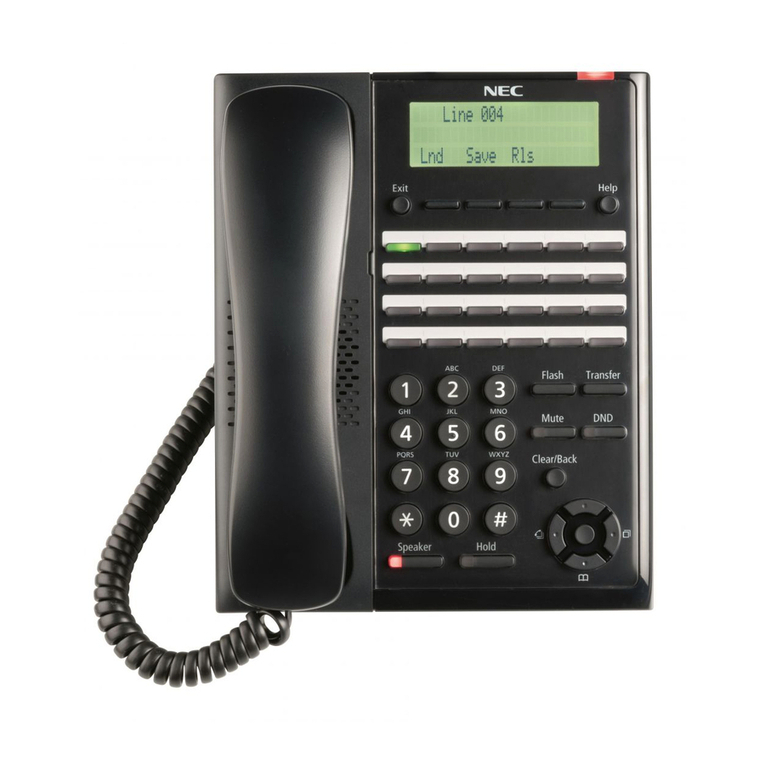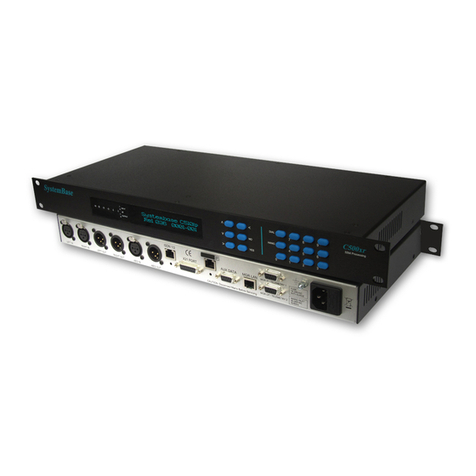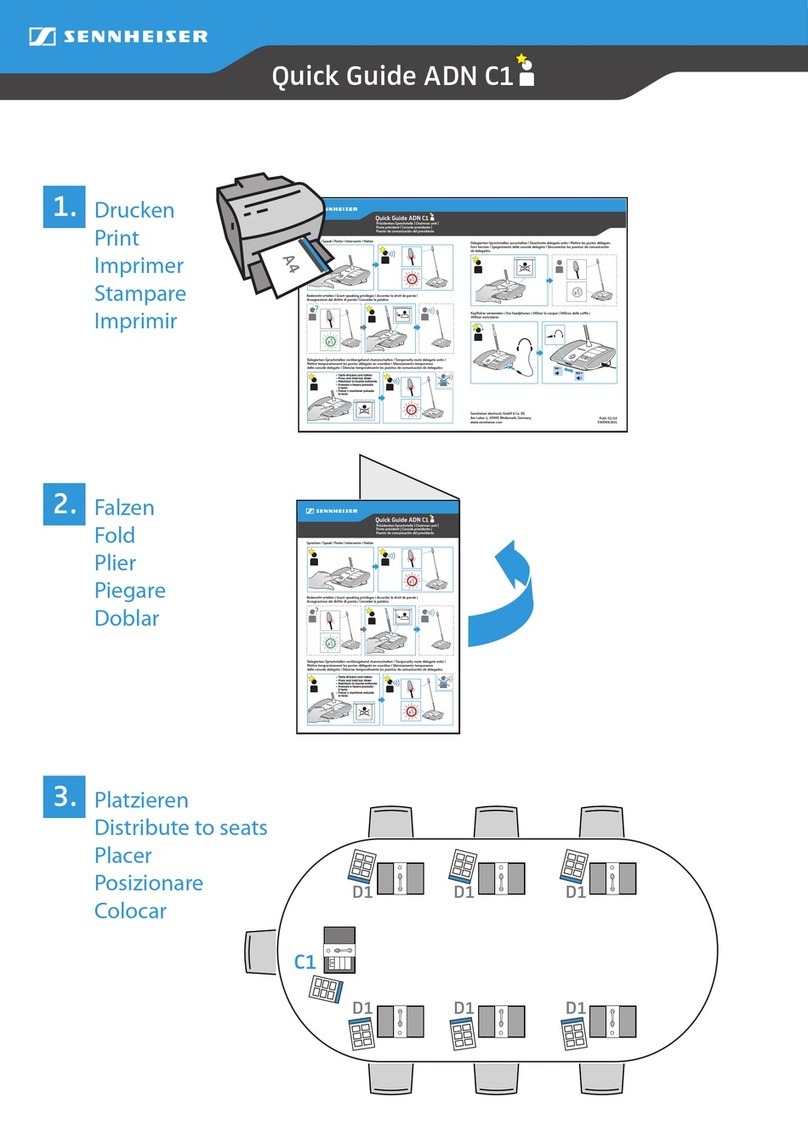Aeta Audio Systems ScoopTeam User manual

Commentary codec
User manual - Draft 0002

ScoopTeam - User manual - Draft 0002
Table of contents
1. Presentation –Overview.................................................................................... 1
2. Functions............................................................................................................ 3
2.1. Audio interfaces and functions..................................................................................................... 4
2.2. Audio encoding and decoding ...................................................................................................... 9
2.3. Audio transmission ..................................................................................................................... 13
2.4. Auxiliary transmission: “relays” (NYA)........................................................................................ 16
2.5. User interface and control.......................................................................................................... 17
3. Physical description and operation principles.............................................. 22
3.1. General principles –Control means ........................................................................................... 22
3.2. Physical description of the equipment....................................................................................... 23
3.3. Initial setup of the Ethernet interfaces ...................................................................................... 30
3.4. Managing links............................................................................................................................ 32
3.5. First level maintenance .............................................................................................................. 33
4. Detailed operating mode –User interface...................................................... 34
4.1. Equipment start-up .................................................................................................................... 34
4.2. Principles for navigating and setting parameters....................................................................... 34
4.3. Description of the user interface pages ..................................................................................... 35
4.4. Setting up a link .......................................................................................................................... 52
4.5. Details on specific objects .......................................................................................................... 60
4.6. Description of the menu............................................................................................................. 65
4.7. Management of the configuration profiles (NYA)...................................................................... 69
4.8. Access control (NYA)................................................................................................................... 70
4.9. Clearing / Backing up / Restoring settings (NYA) ....................................................................... 70
4.10. Operating mode –Remote control application (NYA) ............................................................. 71
5. Technical characteristics ................................................................................ 72
5.1. Characteristics of interfaces ....................................................................................................... 72
5.2. Audio performance..................................................................................................................... 74
5.3. Network protocols and ports ..................................................................................................... 75
5.4. Power supply .............................................................................................................................. 76
5.5. Dimensions and weight .............................................................................................................. 76
5.6. Environmental characteristics.................................................................................................... 76
5.7. Versions and options .................................................................................................................. 77
5.8. Accessories and related products............................................................................................... 78
6. Annexes ............................................................................................................ 78
7. Index.................................................................................................................. 79

ScoopTeam - User manual - Draft 0002
1
1. Presentation –Overview
Important notice:
This document is a draft, and much of its content still has to be edited or completed. In addition, the
ScoopTeam is currently under development and not all features are operational on the current firmware
version. The following abbreviations are used all over this document:
“NYA”= not available on the current firmware version
“TBD” = to be decided/defined/described
“TBC” = to be confirmed/checked
This document applies to firmware version 0002.
ScoopTeam is a commentary unit integrating a codec for live transmission of one or two audio signals.
The main target is TV sports reporting, but the product also fits the needs of live radio sports. The unit
allows to establish communications between the stadium and the studio/MCR or the IBC (for big
events). The communication includes a mono program link in high audio quality (up to 20 kHz
bandwidth), and a second channel for coordination, optionally via a second link.
Basically, the unit is used by two journalists but sometimes it is necessary to add a microphone or two
for a technician or a guest. This unit supports up to four commentary positions in its standard version.
For biggest events, more inputs are needed. To answer such needs, a “premium” version includes more
features, including additional inputs.
For transmission, the unit is mainly designed for IP networks, but it can also use an ISDN line. In either
case the two audio channels can be set with a single destination (transmission in “dual mono” format),
or two separate destinations (double codec). With a mobile option, alternative transmission modes are
available: AoIP over 3G/4G, and mobile voice (including HD Voice capability).
The product is used by journalists and it aims at being as simple to use as possible, with dedicated
buttons and knobs for the routine settings and volume adjustments. More sophisticated settings are
typically reserved for technically-skilled operators, preparing the unit beforehand or using remote
control for live adjustments. Such remote control can be from just besides, or via a remote access from
the radio/TV house.
This chapter gives an overview of the product specifications. For comprehensive information one can
refer to the rest of this document:
Chapter 2 describes the functions and features of the ScoopTeam (with little detail on the
operating modes)
Chapter 3 gives a physical description of the unit, and describes the main operation principles.
Chapter 4 details the user interface and operating modes.
Chapter 5 provides all the technical characteristics of the ScoopTeam
The annexes bring miscellaneous additional information, including an index you can use to look
for a given information topic.
The following table shows the main features of the product.
Functions marked with P are available on the “premium” version only.
Functions marked with in this table are available as options.

2
ScoopTeam - User manual - Draft 0002
Characteristics
Optional
Transmission interfaces
Ethernet/IP transmission interface
2 Ethernet interfaces, 10BaseT / 100BaseT (shared with remote control)
Audio transmission (AoIP) in unicast mode: SIP or “Direct RTP”
Net bit rate 12 to 256 kbit/s (depending on coding algorithm, linear coding excluded)
ISDN transmission interface
One S0 (BRI) interface. Protocols: ETSI, NI-1, NTT
Single codec 64 or 128 kbit/s, or double 64 kbit/s codec (NYA)
5AS auto configuration on incoming calls (NYA)
Mobile network access (integrated)
P
Integrated 2G/3G/3G+/LTE network access module, 2 antenna sockets
Voice mode (NYA): standard telephone or “HD Voice” (7 kHz with AMR-WB)
Packet data mode: IP protocol, SIP or “Direct RTP”, net bit rate 12 to 256 kbit/s (depending on
coding algorithm)
Mobile network access (external)
(NYA)
External 3G/LTE module, connection via USB socket (data mode only)
Audio coding algorithms
(audio modes)
G711 (standard ISDN telephony, AoIP)
GSM, AMR (mobile telephone)
AMR-WB / G722.2 (mobile “HD Voice”)
G722 SRT, H221, H242
MPEG Audio Layer II
MPEG AAC-LC , HE-AAC
OPUS (AoIP only)
Linear L16, L20, L24 (AoIP only)
Mono
Mono
Mono
Mono
Mono, Dual mono
Mono , Dual mono
Mono
Mono, Dual mono
(NYA)
(NYA)
Audio interfaces
2 microphone inputs with phantom power, HP filter, limiter
1 mic/line input with phantom power, HP filter, limiter
1 mic/line input with HP filter, limiter
2 auxiliary line inputs, 1 AES input
4 stereo headphone sockets for monitoring, flexible routing and volume control
1 line output
USB audio device interface (mono)
Ravenna Ethernet interface (2 input channels / 2 output channels)
P
(NYA)
P(NYA)
User interface
Color TFT 7” display
User input: touchscreen display + rotary encoder
Dedicated and assignable backlit pushbuttons
Dedicated and assignable potentiometers
Programmable set-up/dial memories
(NYA)
Remote control and supervision
Remote control via IP for all settings
Remote access over Internet
2 Ethernet interfaces 10BaseT / 100BaseT (shared with audio transmission)
GPIO: 2 inputs / 2 outputs
(NYA)
(NYA)
(NYA)
General
Power: external DC 12V, or 6xAA-type rechargeable batteries (run time > 1 h), charger included
Size 212 x 235 x 102 mm (WxDxH)
Weight < 2.5 kg
USB host interfaces for optional extensions: Wi-Fi...
(NYA)
Table 1 –Main features of the ScoopTeam

ScoopTeam - User manual - Draft 0002
3
2. Functions
Reminder: this chapter details the functions and capability of the ScoopTeam, but not the detailed
operating modes, developed in other chapters.
The following block diagram shows the basic functions of the equipment.
Figure 1 –Functional diagram of the equipment
The AUDIO block deals with the audio interfaces and includes mixing and processing functions. Two
internal mono buses “Program” and “Coordination” are generated and sent to the coding and
transmission parts. Corresponding feedback signals are received from these blocks and used in the
mixing part. Monitoring headphones are fed a configurable and adjustable mix of the block’s input
signals.
The CODEC block deals with the bit rate reduction for transmission, implementing various possible
coding algorithms. Two bidirectional channels are handled.
The TRANSMISSION block handles the access and transport via the available network interface(s).
The User Interface and Control part includes the management thanks to the touch screen display and
several buttons and knobs. In addition, the unit is remote controlled via the IP network interface(s), plus
some GPIO.
Auxiliary functions can be optionally added, e.g. by plugging USB devices providing additional network
interfaces.
User Interface and Control
AUDIO
mixing and
processing CODEC TRANSMISSION
Audio
inputs
Audio
outputs PGM
Coord
Headphones
Network
GPIO
Network
Auxiliary Functions
RAVENNA
USB

4
ScoopTeam - User manual - Draft 0002
2.1. Audio interfaces and functions
The following diagram shows the main features of this functional block.
Figure 2 –Audio processing and mixing functional block
2.1.1. Microphone inputs (Mic 1 and Mic 2)
Each of these two inputs has the following features:
Balanced input, 3-pin female XLR, located on the front panel
Phantom power (48 V, switchable)
High-pass filter, 80 Hz, 18 dB/o (fixed, analog domain)
Limiter (adjustable threshold, switchable, analog domain)
Gain control +0dB to +40dB, 1 dB steps
All parameters controllable by remote
The limiter threshold value is adjustable but common to all 4 microphone inputs.
Lim
HPF
On/Off
HPF
On/Off
Lim
HPF
HPF
Lim MIC1
P48
Off
Mic
power
Mic 1
P48
Off
P48
Off
Mic
power
Mic
power
PAD
20dB
Mic 2
Mic/Line 3
AUX 1&2
Sample
rate
converter
AES/SPDIF
receiver
AES
MIC3
MIC2
Aux 1 & 2
AES 1&2
Line Out
Headphone 1
Headphone 2
Headphone 3
Line
Lim
PAD
20dB
Mic/Line 4
MIC4
Headphone 4
PGM bus
Program FB
Coordination
Coord FB
USB
USB USB
RAVENNA RAVENNA
RAVENNA1&2
USB
RAVENNA1&2
PROGRAM
Level
metering
COORD
Mixer
Lim/Comp

ScoopTeam - User manual - Draft 0002
5
2.1.2. Mic/Line input 3
This input has the following features:
Balanced input, 3-pin female XLR, located on the front panel
Phantom power (48 V, switchable)
Mic/Line switch (pad)
Acceptable level +22 dBu (with “line” setting, pad on)
High-pass filter, 80 Hz, 18 dB/o (defeatable, analog domain)
Limiter (adjustable threshold, switchable, analog domain)
Gain control (Mic position): +0dB to +40dB, 1 dB steps
Gain control (Line position): -30dB to +16dB, 1 dB steps
All parameters controllable by remote
The limiter threshold value is adjustable but common to all 4 microphone inputs.
2.1.3. Mic/Line input 4)
This input has the following features:
Balanced input, 3-pin female XLR, located on the back
Mic/Line switch (pad)
Acceptable level +22 dBu (with “line” setting, pad on)
High-pass filter, 80 Hz, 18 dB/o (defeatable, analog domain)
Limiter (adjustable threshold, switchable, analog domain)
Gain control (Mic position): +0dB to +40dB, 1 dB steps
Gain control (Line position): -30dB to +16dB, 1 dB steps
All parameters controllable by remote
The limiter threshold value is adjustable but common to all 4 microphone inputs.
2.1.4. Line inputs (Aux 1 and Aux 2)
These two inputs are only available on the “premium” version. Each has the following features:
Balanced input, 3-pin female XLR, located on the back
Acceptable level +22 dBu
Gain control -30dB to +16dB, 1 dB steps
All parameters controllable by remote
2.1.5. AES input
This input is only available on the “premium” version, and has the following features:
3-pin female XLR, located on the back
AES 3 standard, SPDIF format accepted
Gain control -30dB to +16dB, 1 dB steps
Integrated SRC accepting an input sampling rate of 32 kHz to 96 kHz
All parameters controllable by remote

6
ScoopTeam - User manual - Draft 0002
2.1.6. USB audio interface (NYA)
This interface is a “device” interface, for a connection with a USB host such as a computer, with
following features:
Mini-B USB socket located on the back
One input channel and one output channel
Input gain control -30dB to +16dB, 1 dB steps
All parameters controllable by remote
2.1.7. RAVENNA interface (NYA)
This interface is only available on the “premium” version, and has the following features:
Ethernet 10/100BaseT, RJ45 socket located on the back
Two input channels (selectable from the source stream) and two output channels
Input gain control -30dB to +16dB, 1 dB steps (for each channel, independently)
All parameters controllable by remote
2.1.8. Line output
This output has the following features:
Balanced output, 3-pin male XLR, located on the back
Full scale level adjustable +4 dBu to +22 dBu, 1 dB steps
All parameters controllable by remote
2.1.9. Headphone outputs
Four outputs are available for monitoring. Each has the following features:
6.35 mm jack located in the front panel
Volume control with a dedicated knob
Flexible routing: see further
2.1.10. Mixing capabilities
The various audio sources are mixed to produce:
The program and coordination output signals. An adjustable compressor/limiter (NYA) is
applied on the program mix.
Monitoring outputs to the headphones.
Outputs to the audio output interfaces.
The sources for mixing include:
The signals from the local audio input interfaces, as listed previously (including the USB and
RAVENNA interfaces), after the gain setting and possible channel processing.
The feedback channels from the program link and the coordination link (Program FB and
Coord FB).

ScoopTeam - User manual - Draft 0002
7
Each output is a configurable mix of the available inputs. The following diagram shows the sources that
are selectable in the mix for the Program and Coordination buses, and for the monitoring outputs.
Each input of the ScoopTeam can be routed to the Program and/or the Coordination mix buses.
A dedicated push-button is available on the desk for the contribution of each microphone input
(Mic 1, Mic 2, Mic/Line 3, Mic/Line 4) to the Program and Coordination buses.
Each headphone monitoring output is fed with a selectable mix of all the inputs, and the
Program and Coordination feedback channels. Every contribution has an adjustable gain and a
routing selection Left/Center/Right (“Center”=both ears).
For each headphone output, a dedicated knob is available on the desk for controlling the gain
of the corresponding microphone in the headphone mix (“side tone” adjustment).
Figure 3 –Mixer diagram, main part
MIC1
AUX 1
MIC3
MIC2
AES 1
MIC4
USB IN
RAVENNA2
AUX 2
AES 2
RAVENNA1
Headphone1L
Headphone2L
Headphone3L
Headphone4L
Headphone1R
Headphone2R
Headphone3R
Headphone4R
Program FB
Coord FB
Summing node
Summing node
w/ dedicated button
Gain + LCR select
+ summing
PGMbus
Coordination

8
ScoopTeam - User manual - Draft 0002
The audio output interfaces (other than headphones) get a selectable mix of the program and
coordination channels and their feedback channels, as visible on the following diagram:
Figure 4 –Output mixer diagram
Note that the Program signal here is the same that is forwarded to the transmission block, i.e. it is the
program picked after the limiter/compressor.
2.1.11. Audio level metering
The level of the following signals is monitored and displayed on the user interface:
Program output (or “transmit”) signal, picked after the compressor/limiter.
Program feedback signal, received from the network link.
Coordination output (or “transmit”) signal.
Coordination feedback signal, received from the network link.
The level monitoring is of PPM type, relative to full scale (full bar = 0 dBFS).
Line
USBOUT
RAVENNA1
RAVENNA2
Program FB
Coord FB
Program *
Coordination

ScoopTeam - User manual - Draft 0002
9
2.2. Audio encoding and decoding
ScoopTeam features several coding algorithms. Their availability depends on the configuration for
transmission: network used and single/double codec mode.
2.2.1. Single codec mode
In this configuration, the selected network interface (ISDN or IP) is used to set up a link with a single
remote device. A single encoder/decoder processes one or two mono audio channels:
With a mono codec, only the program channel is processed and transmitted over the selected
network.
However, when the mobile option is installed, the mobile voice channel can be used for the
Coordination channel.
With a dual mono codec, two audio channels are transmitted (Program and Coordination).
The table below synthetically describes the capabilities in the different cases:
Table 2 –Single codec - Available coding depending on network
Note 1: the “IP” case does not depend whether a wired interface (Ethernet) or mobile interface (3G/LTE)
is used for the network access.
16 24 48 Mono Dual
Mono Dual
G711 64 NYA
G722 64
G722-H221 64 NYA
G722-H242 64 NYA
MPEG L2 NYA 64
MPEG L2 NYA 128 NYA NYA
MPEG L2 192
MPEG L2 256
AAC-LC 16 => 56 NYA
AAC-LC 64 NYA
AAC-LC 96 NYA
AAC-LC 128 NYA NYA NYA
AAC-LC 192 NYA
AAC-LC 256 NYA
HE-AAC 16 => 56 NYA
HE-AAC 64 NYA
HE-AAC 96 NYA
HE-AAC 128 NYA NYA NYA
AAC-LC LOAS 64
HE-AAC LOAS 64
OPUS 12 => 192
Linear L16 768/1536
Linear L20 960/1920
Linear L24 1152/2304
Codec
Frequency (kHz)
Net bit rate
(kbit/s)
IP
ISDN

10
ScoopTeam - User manual - Draft 0002
2.2.2. Double codec mode
In this configuration, two independent connections can be set over the selected network interface (ISDN
or IP) towards possibly two remote devices. One mono codec is operating for each connection, one for
the Program link and one for the Coordination link.
The mobile voice channel is not used in this arrangement.
The table below synthetically describes the capabilities of either codec in the different cases:
Table 3 –Double codec - Available coding depending on network
2.2.3. Details on the coding algorithms
The following bring some precisions about the important features of the various algorithms and
protocols available.
G711 coding
Application: telephony, coordination. Low latency.
G711 is the standard coding used for voice transmission on public telephone networks, and features 300
to 3400 Hz audio bandwidth. This algorithm is typically used for links over IP networks with IP
telephones or VoIP gateways. Via ISDN (NYA), G711 is used for links with telephones or hybrid devices.
G722 coding
Application: commentaries, coordination. Low latency.
This mono coding algorithm at a 64 kbit/s bit rate is a reference for commentaries, and features a 50-
7000 Hz bandwidth.
For ISDN, three synchronisation modes are possible:
“Statistical recovery” byte synchronisation method (alias SRT);
H221 synchronisation; in this case, 1.6 kbit/s from the compressed data are used for this; (NYA)
H221 synchronisation and H242 protocol. This is only available for the ISDN mode. (NYA)
No specific synchronisation is required for the IP mode.
16 24 48
G711 64 NYA
G722 64
G722-H221 64 NYA
G722-H242 64 NYA
MPEG L2 NYA 64
MPEG L2 128
AAC-LC 16 => 56
AAC-LC 64
AAC-LC 96
AAC-LC 128
AAC-LC 192
HE-AAC 16 => 56
HE-AAC 64
AAC-LC LOAS 64
HE-AAC LOAS 64
OPUS 12 => 192
IP
Codec
Frequency (kHz)
Net bit rate
(kbit/s)
ISDN

ScoopTeam - User manual - Draft 0002
11
MPEG Audio Layer 2 coding
Application: mono or stereo music, high quality.
As shown on Table 2, this coding algorithm features a maximum flexibility, with many variations for bit
rate, mono or dual mono channel mode, sampling rates...
The 24 kHz sampling rate (NYA) features a moderate bandwidth (10 kHz) and is rather useful for
commentaries.
The latency is rather high with this sampling rates
ISDN mode specific aspects: J52 (NYA)
For ISDN transmission, MPEG L2 is proposed with two variations:
“MPEG L2 J52”variation (NYA), using the ITU-T J52 protocol for the link negotiation and inverse
multiplexing (B channel aggregation for connections requiring more than 64 kbit/s). For more
details refer to 2.3.2, ISDN interface (page 14).
“MPEG L2”variation, without the J52 protocol. At 128 kbit/s, this variation uses a system for
inverse multiplexing two B channels that is proprietary but compatible with several codecs on
the market.
MPEG AAC algorithms
Application: music, low capacity transmission channels.
These algorithms feature a very high compression ratio, for a given audio quality, compared to Layer 2.
They operate at a sampling rate of 48 kHz, and several bit rates: 16, 20, 24, 32, 40, 48, 56, 64, 96, 128,
192, 256 kbit/s. Two coding variations are available:
MPEG AAC-LC (“Low Complexity”): lower compression than HE-AAC, but lower latency.
MPEG HE-AAC (“High Efficiency” AAC): higher compression, and the bit rate is limited to
128 kbit/s for this variation.
OPUS coding
Application music, low capacity transmission channels. Moderate latency.
Opus is an open source coding algorithm (under BSD license), described by RFC6716 from the IETF. Like
MPEG coding algorithms, it is a wide band audio codec, but it features distinctive characteristics:
Low latency; the algorithmic delay of Opus is very low compared to MPEG coding (Layer 2, AAC,
HE-AAC...).
Adaptability: Opus features many parameters influencing its performance, but it is possible to
adapt them automatically depending on the external constraints and the signal characteristics.
In the ScoopTeam, the configuration stays very simple: the user just imposes the desired bit
rate, and the codec automatically adjusts the other parameters (for instance the audio
bandwidth).
Capacity to apply changes “on the fly”: the coding allows changing its operation parameters on
the fly, with no interruption and no artefacts when switching. In this way the bit rate can be
changed during the link on the ScoopTeam, without any audio noise or dropout.
In addition, when the remote device is another AETA codec, it will automatically apply the same
bit rate change to the stream it is transmitting.
Opus coding is only available for IP networks (wired or mobile).

12
ScoopTeam - User manual - Draft 0002
Linear coding
Application music, transmission media with very high capacity and reliability.
The linear coding is in fact the absence of coding/compression, the audio data are transmitted without
information loss and with no bit rate reduction. Obviously this implies a very high bit rate; therefore
linear coding is only usable over an IP network, and with a very high bandwidth and a very good quality
of service, such as a local area network or a high reliability private WAN.
The coding features a sampling frequency of 48 kHz and three variations L16, L20 and L24 for a sample
resolution of respectively 16 bits, 20 bits, or 24 bits for the transmitted audio. With each variation it is
possible to select a mono or dual mono channel mode.
The linear coding is only available for IP networks.
It is not recommended on mobile IP networks due to the required bit rate and the poor quality of
service expected from a mobile network.
2.2.4. Mobile voice and HD voice (NYA)
Application: telephony and commentaries, mobile coordination. Moderate latency.
When the unit includes the mobile option, the mobile voice channel can be used for the Coordination
channel.
The standard algorithm used in the network is GSM or AMR. These algorithms are exclusively used for
speech transmission over mobile telephone networks, with a 300 to 3400 Hz audio bandwidth.
Whenever needed, gateways perform transcoding in order to interface with fixed PSTN, ISDN and IP
networks.
When the mobile network supports the so called “HD Voice” service, the AMR-WB coding (standardised
as G722.2 by the ITU-T) is used between compatible mobile terminals, and provides speech transmission
with a 50-7000 Hz bandwidth. ScoopTeam automatically implements this algorithm in mobile voice
mode every time it is possible, and automatically falls back to standard voice coding if not (when the
network does not support HD voice, or the remote terminal is not compatible).

ScoopTeam - User manual - Draft 0002
13
2.3. Audio transmission
The ScoopTeam features in all versions an Ethernet interface for IP protocol networks. Additional
interfaces are available as options: ISDN interface (BRI), mobile network access, Wi-Fi interface (NYA).
2.3.1. Ethernet/IP interface
The IP interface is a 10BaseT/100BaseT Ethernet interface allowing transmission of the audio programs
in a wide range of possible bit rates. Audio streams are always transported under the RTP/UDP protocol.
AoIP transmission
The ScoopTeam performs AoIP (Audio over IP) transmission, exchanging unicast streams with one (or
two) remote device(s), generally bidirectional. This mode can be used on all types of networks links, LAN
or WAN, including links via Internet. The ScoopTeam implements the SIP protocol, which is required for
audio contribution links by the EBU Tech3326 recommendation, also known as “N/ACIP”. Links can be
set up in three ways:
“Peer to peer” SIP connection between two compatible units.
Use of a SIP proxy server to set up the link, or a SIP PBX.
“Peer to peer” connection without SIP, called “Direct RTP”. This operation mode can be used
for interoperation with devices that do not support SIP, or for overcoming possible network
blocking that would specifically affect the SIP protocol.
The audio coding algorithm can be selected depending on the required quality and the available
network bandwidth. The available algorithms are described in 2.2, Audio encoding and decoding.
SIP and SDP protocols
The SIP protocol is a signalling protocol used for live media transmission over IP connections, which
allows the interoperation with IP phones and SIP compatible audio codecs, in a way similar to ISDN or
telephone connections. Details about the SIP protocols can be found in TBD.
One significant advantage is the inclusion of SDP, a protocol which allows the connecting devices to
automatically negotiate and agree on the coding profile to use. Thanks to this system, it is not necessary
to set the units in the same way before setting up a connection. Moreover, the calling party needs not
know how the remote unit is configured before initiating a link.
Note: the SIP protocol does not mandatorily imply the use of a server. Codecs can set up point-to-
point links using this protocol, and benefit from some its advantages.
Conversely, for the “Direct RTP” mode, which includes no signalling, it is necessary to configure
beforehand in the same way the two units to be connected.
Double AoIP codec
With the SIP protocol, the ScoopTeam can operate as two mono AoIP codecs. Each of the codecs can
have its own SIP registration and is managed independently from the other codec.
The available algorithms for each codec are described in 2.2.2, Double codec mode (see Table 3 –
Double codec - Available coding depending on network).
Packet duplication
ScoopTeam also proposes an RTP transmission mode with enhanced reliability, using packet replication.
When enabling this mode, every packet is transmitted twice; with such system a lost packet has no
effect since the receiver still gets the other copy of the packet. In this way, stable links can be obtained
even with a high packet loss rate. Of course, as a disadvantage the bit rate is double; you must make
sure this stays compatible with the transmission medium.

14
ScoopTeam - User manual - Draft 0002
Remote control via IP
In addition, the Ethernet interface can be used for configuring or remote controlling the unit. Refer to
chapter 2.5, “User interface and control for more information on this feature.
2.3.2. ISDN interface
For access to the ISDN, the transmission interface is one S0 BRI (Basic Rate Interface), for transmission
over one to two 64 kbit/s B channels. Thus, the total available bit rate ranges is 64 or 128 kbit/s.
In “double codec”mode, each of the possible links uses one B channel on this single line.
Network protocols
Available protocols:
“Euro ISDN”(or ETSI), default protocol valid for a large number of countries, especially all over
Europe.
“NTT”: valid for the Japanese network of NTT
“NI-1”: valid for numerous operators in North America. This choice is also suitable for the
connection to network equipment with “NI-2”protocol”.
In North America (USA and Canada), the available interface is often a U0 interface (instead of S0). In
such case an “NT1” network adapter must be inserted between the line and the ScoopTeam. Such
adapter can be found on the local market.
5A System (NYA)
Setting an ISDN connection is often difficult, at least because of the numerous coding parameters to be
set. Moreover, with most proprietary algorithms, it is mandatory for the two devices to have exactly the
same settings, otherwise the connection will fail, and sometimes it is not easy to find out the reason.
5A stands for Aeta Audio Advanced Automatic Adjustment. This system makes it easier to set an ISDN
connection, because the codec, on receiving a call, automatically adjusts itself, following the calling
party algorithm and parameters.
When the 5A System is enabled on the unit and a call is received, the unit first detects the coding
algorithm used by the calling codec, and also senses its parameters: audio mode (mono, dual mono…),
sampling rate, bit rate, inverse multiplexing protocol, etc. Then the unit can decode the compressed
audio from the remote unit. In addition, the unit will use these same settings for encoding and sending
audio to the remote unit, so that the remote unit can also decode the outgoing audio programme. The
whole process just takes a few seconds. Of course, all compatible coding configurations can be detected
automatically by the 5A System.
Note that the 5A system is only relevant for ISDN connections.
J52 (NYA)
The ITU-T J52 recommendation was defined in order to allow the interoperability of multimedia
terminals over the ISDN1, using common coding standards. It includes the following features:
Support of ITU-T recommended coding algorithms: G711, G722, MPEG Layer II
Framing as per ITU-T H221 recommendation, ensuring byte synchronisation and interchannel
synchronisation when more than one 64 kbit/s B channel is required for the desired bit rate;
Interoperation procedures according to ITU-T H242 recommendation;
1J52 is only relevant for ISDN connections

ScoopTeam - User manual - Draft 0002
15
2.3.3. Mobile network access
Units equipped with the “Mobile”option include an integrated module for access to mobile networks,
and a holder for a SIM card.
The accessible networks are 2G (GSM, EDGE), 3G (UMTS), 3G+ (HSDPA, HSUPA, HPA…), and 4G/LTE.
For the operation, at least one multiband antenna (to be selected for compliance with the mobile
network characteristics) must be connected on ScoopTeam. An antenna “diversity” feature gives an
opportunity to improve the stability when the radio reception quality is poor, by connecting a second
antenna.
Mobile voice mode –HD Voice (NYA)
The integrated module allows to use the mobile phone service, for communicating with all ISDN or PSTN
telephone terminals or hybrids, or with other mobile terminals. The quality is in such case that of mobile
connections, with a 300-3400 Hz bandwidth and coding such as GSM, EFR, AMR...
Now many mobile networks also propose “HD Voice”, an extension of this mobile telephone service.
With this new capability, compatible terminals implement the AMR-WB coding algorithm (standardised
as G722.2 by the ITU-T) and provide speech transmission with a 50-7000 Hz bandwidth and a quality
very similar to the well-known G722. Automatic fallback to the standard coding takes place if the
network does not support the service or one of the terminals does not feature this capability.
In single codec mode, the mobile voice channel can be used for coordination.
Mobile IP mode
The other service available with mobile access is the data packet transmission mode, with IP protocol.
This mode brings similar capabilities as a wired IP connection via the Ethernet interface, as described
above in 2.3.1, with some distinctive characteristics:
This requires a subscription including access to the data service, with conditions compliant with
the application. Among other requirements, an APN (Access Point Name) must be provided
that allows this type of media stream. Some operators provide such allowance in a “VoIP”
option.
The available bit rate depends on various factors; first the network technology
(2G/3G/3G+/4G…), but also the traffic level in the radio cell, the operator’s network capacity,
possibly the type of subscription. This may bring on restrictions for the usable compression
algorithms.
Setting a link implies first activating the data connection, before actually initiating an audio
stream transmission link.
Using an external USB module
Instead of the integrated module, it is possible to plug a USB mobile module or “key”, in order to access
mobile IP transmission, with more or less similar conditions as described above.
However be aware:
This capability is optional (but included with the “Mobile” option).
The USB module must be from the list of devices supported by AETA. As this list is evolving,
please check our web site for up-to-date information.
The “HD Voice” mode is not available in this way.
USB devices do not feature antenna diversity.

16
ScoopTeam - User manual - Draft 0002
2.3.4. Wi-Fi interface (NYA)
A specific USB device (reference TBD) can be used to provide access to a Wi-Fi network.
It is possible to connect to an access point by entering the SSID and password for the network. Access
control requiring a certificate and/or a login via a web browser is not supported.
The Wi-Fi connection can be used for remote control links and/or for AoIP connections.
2.3.5. Managing audio links
The audio transmission implies a link/session setup phase.
One of the transmission interfaces is selected as the default interface on the ScoopTeam. A call towards
a remote unit, initiated by the user of the ScoopTeam, is implicitly sent through this default interface.
The default interface can also receive and accept incoming calls from a remote device. The ScoopTeam
automatically picks up such calls.
On the other hand, an incoming call on an interface other than the default interface may be accepted
under certain conditions. These are described more precisely in 4.4.5, “Receiving calls”. In such case, the
ScoopTeam first switches to the suitable interface, and then processes the incoming call. When the link
is released, it will come back to its previous state (and default interface). Note: If the unit is in double
codec mode and one codec is busy, the other codec is not available for calls on the other network
interface (e.g. IP link active, no ISDN call is acceptable).
2.4. Auxiliary transmission: “relays” (NYA)
In addition to the main function of the ScoopTeam, which is the transmission of one or two main audio
programmes, auxiliary functions are available.
During an audio connection, two binary states can be transmitted end-to-end along with the audio
stream.
The transmitted data (also called “Contacts”) can be set via the user interface, using keys or a menu, or
set by input GPIs (see further in 2.5.5, GPIO).
The received states (also called “Info”) can be displayed on the screen and/or can activate relays/GPO
(see further in 2.5.5, GPIO).
This feature is only compatible with AETA products, because it is not covered by independent standards.
It is available depending on the transmission context, as follows:
For IP transmission and the SIP protocol, the feature is always available whatever the coding
algorithm (except L16/L20/L24).
For ISDN transmission, the feature is available only for G722-H242 or MPEG Layer II with J52.
The feature is not available in other configurations, including mobile voice transmission.
In double codec mode, this feature is only available for Codec 1.

ScoopTeam - User manual - Draft 0002
17
2.5. User interface and control
The control and supervision of the equipment (configuration, communication management, status
monitoring), is carried out in two general ways: “local” user interface using the physical display and
input devices, or “remote” control.
2.5.1. User interface
The user interface elements are as follows:
Color 7” TFT display with touch screen
One rotary encoder to adjust settings
Monitoring shortcut key and Communication shortcut key
Dedicated backlit keys for each commentator position: Program key, Coord key
Dedicated potentiometers for volume control for each commentator position: general
headphone volume, side tone volume
For commentator positions 1 and 2, assignable potentiometers, 4 for each position. These
knobs can be configured for directly controlling the gain of selected sources in the monitoring
mix.
7 assignable backlit function keys. These keys can be assigned various functions, as detailed
further in 2.5.6, Assignable function keys.
The operation is described further in the following chapters.
2.5.2. Remote control
Basically all the parameters of the unit can be remote controlled via IP, using the unit’s control protocol.
Two control tools are available for operating the unit by remote.
A dedicated application (NYA) provides complete control over the unit from a computer
(Windows, iOS, Android). See in chapter xxx the detailed operating mode.
An embedded html server provides html pages that enable partial control using a web browser,
via port 80 (default port for the HTTP protocol). This control mode can be used from any
computer regardless of its OS (or a mobile device with a web browser), and the embedded
pages are compatible with all current browsers. No software installation is needed on the
control device. However, this tool has a limited range of features and is not suitable for normal
operation.
2.5.3. Remote control interfaces
The unit provides several ways (NYA) to remote control the unit via IP:
The main Ethernet interface, used for audio streaming, can be used for remote control as well.
The auxiliary Ethernet interface (10/100BaseT) is the normal default interface for remote
control.
The data connection over the mobile network can be used for remote control.
Connection via Wi-Fi (see above in 2.3.4, Wi-Fi interface (NYA)).
The interface that is used is selected by the user from the unit’s menu.

18
ScoopTeam - User manual - Draft 0002
2.5.4. Remote access (NYA)
A computer connected on the same LAN as the ScoopTeam can easily take control over the unit.
However, in most other cases, and especially if the link is over the Internet, there will be a need to go
through a NAT router and/or a firewall.
The ScoopTeam features the capability to set up and initiate a connection to a remote device or server,
which will allow this remote unit to take control over the ScoopTeam in such situation, with the same
capabilities as a “local” connection.
The access method and protocol are still TBD.
Table of contents
Other Aeta Audio Systems Conference System manuals
